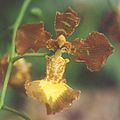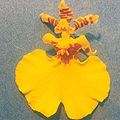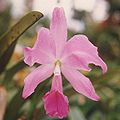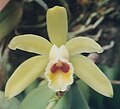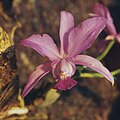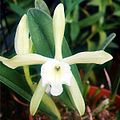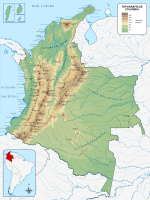Flora of Colombia
The Flora of Colombia is characterized by over 32,000 species of green plants. [1]
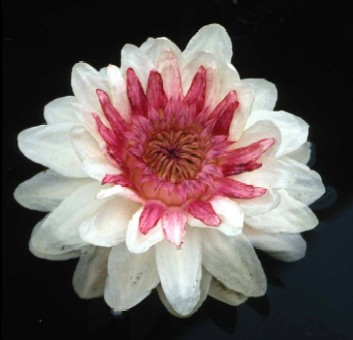
National Flower of Colombia[edit]
The national flower of Colombia is the orchid Cattleya trianae which was named after the Colombian naturalist José Jerónimo Triana. The orchid was selected by botanist Emilio Robledo, in representation of the Colombian Academy of History to determine the most representative flowering plant of Colombia. He described it as one of the most beautiful flowers in the world and selected Cattleya trianae as National symbol.
National Tree of Colombia[edit]
The national tree of Colombia is the palm Ceroxylon quindiuense (Quindío wax palm) which was named after the Colombian Department of Quindío where is located the Cocora valley, the only habitat of this restricted range species. The Quindío wax palm was selected as the national tree by the government of Belisario Betancur and was the first tree officially declared as a protected species in Colombia. C. quindiuense is the only palm that grows at such high altitudes in Colombia and is the tallest monocot in the world.
Endemism[edit]


Colombia has the largest number of endemic species (species that are not found naturally anywhere else) worldwide. About 10% of the species in the world live in Colombia. Some determinant factors in the distribution range of the species are the wide diversity of habitats available due to the variety of altitudes, weather conditions, temperatures, soils and sunlight on the coasts, in the Andes [2] and in the rainforest lowlands.
Endemics can easily become endangered or extinct due to their restricted habitat and vulnerability to the actions of man, including the introduction of new organisms.
Ecoregions with high endemism[edit]
According to the Colombian Ministry of Environment, the following ecoregions have the highest percentage of botanic endemic species:
- Colombian Amazon basin
- Catatumbo River basin
- Mid Magdalena river basin
- Pacific coastal region
Tree species[edit]
Many of the Colombian trees are endangered species due to the high quality of the woods and timber industry exploitation (such as Colombian oak Quercus humboldtidiana and Colombian mahogany) and as source of tanning substances for the leather industry (such as mangrove and Encenillo tree Weinmannia tomentosa). Some tree species described in Colombia are:


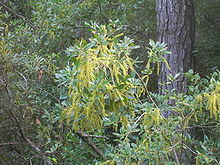
- Anadenanthera peregrina
- Amazon Grape
- Adenolisianthus arboreus
- Aiouea angulata
- Anthodiscus montanus
- Astrocaryum triandrum
- Attalea septuagenata
- Bactris coloniata
- Banara ibaguensis
- Blakea granatensis
- Bonnetia holostyla
- Bulnesia carrapo
- Brazil Nut
- Borojoa patinoi
- Caryocar nuciferum
- Caryodaphnopsis cogolloi
- Casearia megacarpa
- Coccothrinax argentata
- Cryosophila kalbreyeri
- Cyathea incana
- Cyrilla racemiflora
- Chelyocarpus dianeurus
- Cherimoya
- Dendropanax colombianus
- Esenbeckia alata
- Feijoa
- Guaiacum officinale
- Garcia nutans
- Graffenrieda grandifolia
- Hirtella enneandra
- Huberodendron patinoi
- Hampea thespesioides
- Henriettella goudotiana
- Humiriastrum melanocarpum
- Itaya amicorum
- Macrosamanea consanguinea
- Neosprucea sararensis
- Platonia insignis
- Quararibea asterolepis
- Quararibea cordata
- Ouratea tumacoensis
- Reinhardtia ssp.
- Ruehssia cundurango
- Simaba cedron
- Syagrus smithii
- Tessmannianthus quadridomius
- Trigonobalanus excelsa
Fruits of Colombia[edit]
-
Chontaduro fruit (Bactris gasipaes)
-
Tomato tree or tamarillo (Solanum betaceum)
-
Mamoncillo (Melicoccus bijugatus)
-
Arazá or Strawberry guava (Psidium cattleianum)
-
Uchuva or Cape gooseberry fruit (Physalis edulis)
-
Guanabana or Soursop fruit (Annona muricata)
-
Marañon or Cashew (Anacardium occidentale)
-
Feijoa or Pineapple guava (Feijoa sellowiana)
-
Lulo or Naranjilla (Solanum quitoense)
-
Maypop (Passiflora incarnata)
-
Gulupa or purple passion fruit (Passiflora edulis)
Genera[edit]
There are over 3900 Genera in the flora of Colombia [1] Some representational Genera are included below.


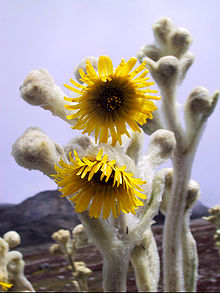
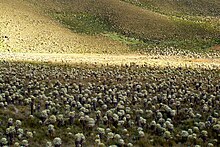







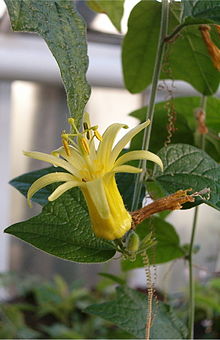


Abarema[edit]
Acidocroton[edit]
Aiphanes[edit]
Aniba[edit]
Brownea[edit]
Brunellia[edit]
- Brunellia almaguerensis
- Brunellia antioquensis
- Brunellia boqueronensis
- Brunellia elliptica
- Brunellia farallonensis
- Brunellia macrophylla
- Brunellia occidentalis
- Brunellia penderiscana
- Brunellia racemifera
- Brunellia rufa
- Brunellia subsessilis
Calatola[edit]
Centronia[edit]
Ceroxylon[edit]
Clusia[edit]
Eschweilera[edit]
- Eschweilera bogotensis
- Eschweilera boltenii
- Eschweilera integricalyx
- Eschweilera integrifolia
- Eschweilera pittieri
- Eschweilera punctata
- Eschweilera rimbachii
- Eschweilera sclerophylla
Espeletia[edit]
Freziera[edit]
- Freziera echinata
- Freziera euryoides
- Freziera jaramilloi
- Freziera longipes
- Freziera punctata
- Freziera retinveria
- Freziera sessiliflora
- Freziera smithiana
- Freziera stuebelii
- Freziera velutina
Grias[edit]
Guarea[edit]
Gustavia[edit]
- Gustavia excelsa
- Gustavia foliosa
- Gustavia gracillima
- Gustavia latifolia
- Gustavia longifuniculata
- Gustavia monocaulis
- Gustavia petiolata
- Gustavia pubescens
- Gustavia santanderiensis
- Gustavia sessilis
- Gustavia verticillata
Herrania[edit]
Huilaea[edit]
- Huilaea kirkbridei
- Huilaea macrocarpa
- Huilaea minor
- Huilaea mutisiana
- Huilaea occidentalis
- Huilaea penduliflora
Inga[edit]
- Inga allenii
- Inga coragypsea
- Inga goniocalyx
- Inga interfluminensis
- Inga macarenensis
- Inga mucuna
- Inga saffordiana
Lejeunea[edit]
- Lejeunea drehwaldii (syn. Sphaerolejeunea umbilicata[3])
Leptolejeunea[edit]
Licania[edit]
Macrolobium[edit]
Magnolia[edit]
- Magnolia calimaensis
- Magnolia calophylla
- Magnolia cararensis
- Magnolia caricifragrans
- Magnolia cespedesii
- Magnolia colombiana
- Magnolia espinalii
- Magnolia georgii
- Magnolia gilbertoi
- Magnolia guatapensis
- Magnolia henaoi
- Magnolia hernandezii
- Magnolia katiorum
- Magnolia lenticellata
- Magnolia mahechae
- Magnolia narinensis
- Magnolia polyhypsophylla
- Magnolia santanderiana
- Magnolia urraoense
- Magnolia virolinensis
- Magnolia wolfii
- Magnolia yarumalense
Mayna[edit]
Meriania[edit]
Metteniusa[edit]
Miconia[edit]
Oenocarpus[edit]
Orphanodendron[edit]
Parmentiera[edit]
Passiflora[edit]
Phytelephas[edit]
Pouteria[edit]
Pradosia[edit]
Prunus[edit]
- Prunus buxifolia
- Prunus guanaiensis
- Prunus huantensis
- Prunus integrifolia
- Prunus littlei
- Prunus subcorymbosa
- Prunus villegasiana, synonym of Prunus integrifolia
Rinorea[edit]
- Rinorea antioquiensis
- Rinorea cordata
- Rinorea haughtii
- Rinorea hymenosepala
- Rinorea laurifolia
- Rinorea marginata
- Rinorea ulmifolia
Rollinia[edit]
Romeroa[edit]
Schoenocephalium[edit]
Solanum[edit]
- Solanum sibundoyense
- Solanum betaceum (tamarillo)
Streptosolen[edit]
Swartzia[edit]
Utricularia[edit]
- Utricularia neottioides
- Utricularia nervosa
- Utricularia oliveriana
- Utricularia pusilla
- Utricularia triloba
Vantanea[edit]
Wettinia[edit]
Xylosma[edit]
Zamia[edit]
Zygia[edit]
Orchid species[edit]
Colombia has the largest number of orchids in the world. Among others:
Frondaria[edit]
Restrepia[edit]
See also[edit]
References[edit]
- ^ a b "Checklist of Colombian Plants". Neotropical Flora. Arizona State University.
- ^ "Plantas y Flora de Colombia". Plantas de Colombia, VisitaConcepcion.
- ^ "Lejeunea drehwaldii". Global Biodiversity Information Facility. Retrieved 2024-04-10.


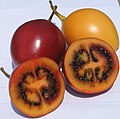









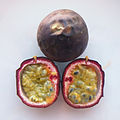





![Restrepia cuprea]](http://upload.wikimedia.org/wikipedia/commons/thumb/3/36/Restrepia_cuprea_Orchi_01.jpg/90px-Restrepia_cuprea_Orchi_01.jpg)




















































